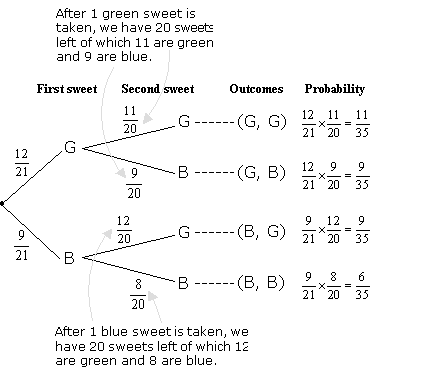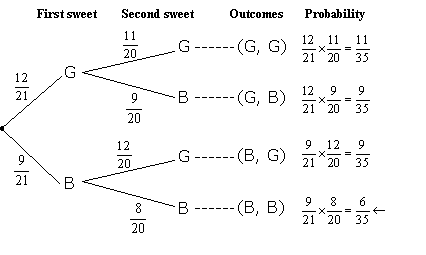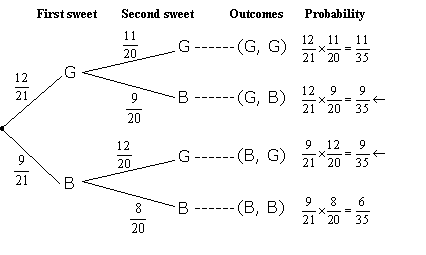What Is The Probability Of Drawing A Red Card, Not Replacing It, And Then Drawing Another Red Card?
Related Pages
Probability Of An Event
More Lessons On Probability
Probability Tree Diagrams
Dependent Events
What Is Probability Without Replacement Or Dependent Probability?
In some experiments, the sample space may change for the dissimilar events. For example, a marble may be taken from a handbag with xx marbles so a second marble is taken without replacing the outset marble. The sample space for the second event is so 19 marbles instead of 20 marbles.
This is chosen probability without replacement or dependent probability. We tin can use a tree diagram to help united states find the probability without replacement.
How To Find The Probability Without Replacement Or Dependent Probability?
Step one: Depict the Probability Tree Diagram and write the probability of each branch. (Remember that the objects are not replaced)
Stride 2: Wait for all the available paths (or branches) of a item outcome.
Stride 3: Multiply along the branches and add vertically to find the probability of the result.
Example:
A jar consists of 21 sweets. 12 are dark-green and 9 are blue. William picked two sweets at random.
a) Draw a tree diagram to represent the experiment.
b) Observe the probability that
i) both sweets are blue.
ii) i sweet is blue and ane sweetness is green.
c) William randomly took a tertiary sweetness. Find the probability that:
i) all three sweets are greenish?
2) at least i of the sweet is blue?
Solution:
a) Although both sweets were taken together information technology is similar to picking one sweet and then the second sweet without replacing the first sweet.

Check that the probabilities in the terminal column add together up to 1.
![]()

b) i) P(both sweets are blueish) = P(B, B)
![]()

ii) P(ane sugariness is bluish and 1 sweet is green) = P(Yard, B) or P(B, M)
![]()
c) i) P(all three sweets are green) = P(1000, G, G)
![]()
ii) P(at least i sweet is blue) = ane – P(all three sweets are greenish)

What Is The Departure Betwixt Probability With Replacement (Independent Events) And Probability Without Replacement (Dependent Events) And How To Employ A Probability Tree Diagram?
Examples:
-
Adam has a bag containing iv yellow gumdrops and one red gumdrop. He volition eat ane of the gumdrops, and a few minutes afterward, he will eat a second gumdrop.
a) Depict the tree diagram for the experiment.
b) What is the probability that Adam volition eat a yellow gumdrop get-go and a light-green gumdrop 2nd?
c) What is the probability that Adam will eat two yellowish gumdrops?
d) What is the probability that Adam will eat two gumdrops with the same color?
e) What is the probability that Adam will consume two gumdrops of different colors?
-
A jar contains four blackness marbles and 3 cerise marbles. Ii marbles are drawn without replacement.
a) Draw the tree diagram for the experiment.
b) Detect probabilities for P(BB), P(BR), P(RB), P(WW), P(at least i Carmine), P(exactly i red)
-
Two marbles are drawn without replacement from a jar containing four black and 6 white marbles.
a) Depict the tree diagram for the experiment.
b) Detect the probabilities for P(at least one black marble), P(same color), P(BW), P(exactly one black marble)
- Show Video Lesson
Probability Question Using Tree Diagrams (Without Replacement)
Example:
A pocketbook contains 5 blueish balls and 4 red balls. A ball is picked and not replaced.
What is the probability of picking at least one red ball?
- Show Video Lesson
How To Calculate Probability With And Without Replacement?
A visual tutorial on how to calculate probability with and without replacement using marbles.
- Show Video Lesson
How To Calculate Probability Without Replacement Or Dependent Probability?
Example:
Andrea has eight blue socks and 4 red socks in her drawer. She chooses one sock at random and puts it on. She then chooses some other sock without looking.
Discover the probability of the following event P(red, then red).
- Show Video Lesson
Try the free Mathway calculator and problem solver below to practice various math topics. Try the given examples, or type in your own problem and check your answer with the step-past-footstep explanations.

We welcome your feedback, comments and questions most this site or page. Please submit your feedback or enquiries via our Feedback folio.
Source: https://www.onlinemathlearning.com/probability-without-replacement.html
Posted by: kussreearly.blogspot.com


0 Response to "What Is The Probability Of Drawing A Red Card, Not Replacing It, And Then Drawing Another Red Card?"
Post a Comment